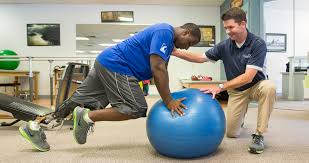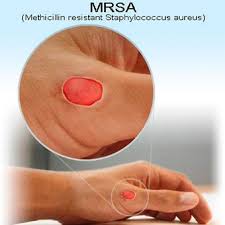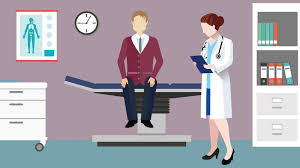
Consultation with a physical therapist
Order Instructions:
Assignment #2: Consultation
Interview a physical therapist who provides client-related consultative services. Submit a 2-3 page summary of the interview, including but not limited to: name and title of person interviewed, date and type of interview (in-person, phone, electronic), the type of consultative activity, how they got involved in the activity, expertise required to serve as a consultant for that activity, reimbursement for consultative services (if any), any legal or risk related factors. NOTE: Consultation is not regular clinical physical therapy. All PTs provide patient-related consultation. Client-related consultation is when a PT has expertise in a particular area and provides expert opinion regarding situations that do not directly involve patient care. Examples of client-related consultation include but are not limited to: Ergonomic workplace assessment, Rules and Regulations compliance, ADA compliance recommendations, Court testimony as an expert witness, Development of clinical or academic programs, Insurance claim reviewer, etc.
ALTERNATE ASSIGNMENT: If you are unable to find a consulting PT to interview, you may write a paper about client-related consultation activities that a PT might engage in. Your paper should include the type of consultative activity, how a PT would get involved in the activity, education or expertise required to serve as a consultant for that activity, reimbursement for consultative services (if any), and any legal or risk related factors related to consultation work in that area. The emphasis of the paper should be on the role of a PT as a consultant. For example, the paper should not be about ergonomics, but about how a PT would serve as an ergonomic consultant.
Assignment requirement-
Instructions:All assignments are to be word processed; 12 point font and double spaced are preferred. Other than the forms for Assignment #1, handwritten assignments will not be accepted. Do not use color, pictures, etc. in your documents. Use only black text. Number the pages and make sure your name is on every page.
In this assignment since first option is not possible to interview a Physical Therapist, I would like to use alternate assignment and write the paper. The reference book for this course is Guide TO Physical Therapist Practice 2nd edition. The name of this course is Consultation, Screening and Delegation. I would like to complete this assignment within 7 days. Also when I chatted with your representative he gave me the price as $48.96/ assignment if I take more than 1 assignment. I intend to take more than 1 assignment, but would like to see the outcome of this assignment first.
NB
We will have the task ready by 3rd December 2014; 2300 hrs
SAMPLE ANSWER
Physical therapists are licensed or certified health care professionals who provide services to aid in restoring function, mobility, prevent physical disabilities, and relieve pain of patients with certain injuries or diseases. They work closely with clients and patients to promote and maintain their overall physical fitness for healthy living. Patients may include people who have been involved in an accident and others who may have disabling conditions such as head injuries, fractures, heart disease, back pain, and arthritis among others. Usually, physical therapists work in various settings such as private offices, hospitals, outpatient clinics, sports facilities, and schools. Their work, depending on what they are assigned to do, can be physically demanding as they have to lift, stand for long, and kneel. They also lift patients or help them stand as well as move heavy machineries. Typically, as part of their roles, physical therapists take client’s history and perform tests that help them to identify potential and inherent problems. Based on their analysis, they are able to determine a client’s diagnosis and prognosis, which they use to set goals for rehabilitation and habilitation (Dreeben-Irimia, 2011).
Physical therapists act as consultants through whom they share their advice and opinion with patients, schools, health care providers, businesses, and organizations. Consultations occur upon client’s request. It may also occur when other health care professionals seek advice about physical therapy of their patients. Likewise, schools and business may consult physical therapists on injury prevention and ergonomics. For instance, in school setting, physical therapists may be consulted to perform therapeutic interventions such as prevention strategies and adaptations, and focusing on mobility and safe participation in routines and activities in the learning environments. In school settings, they gather information from stakeholders that help them to plan for their interventions. They collaborate with teachers and parents to promote students’ inclusion in the intervention activities. In this case, they offer education on safe transportation of students, safe play grounds, and how to promote their physical fitness (Scott, Petrosino & Cooperman, 2008).
Dreeben-Irimia (2011) stipulates that physical therapist consultants may also be contacted by businesses to offers their advice and opinions on ergonomics. Ergonomics refers to adapting people’s environment, equipments, and activities to fit their physical capacities and needs. Therapists offer people ergonomic guidelines that should be incorporated in people’s daily activities. In this case, physical therapist assesses the ergonomic needs and determines how to make people more comfortable in their environment while at the same time reducing the risk of injury. To achieve this, physical therapists educate workers on the tips such as exercise and guidelines and back injury prevention.
Physical therapy consultants educate workers on ways of exercising to improve their physical fitness and minimize the likelihood of work place injury. They teach the employees on the benefits of exercising and safe ways to do the same. In such cases, they demonstrate to their employees how to exercise safely. These exercises are majorly concerned in reducing back pain and keeping the body fit to perform various tasks throughout the day. Further, physical therapy consultants also emphasize on workplace stretching. This is in response to the fact that most work place spinal and musculoskeletal disorders culminate from back strains and trauma injuries. As such, physical therapists educate employees Concentra’s warm up and stretching. All these are tailored to specific workplaces where therapists provide approximately one hour training (Dreeben-Irimia, 2011). It is notable that back injuries are as a result of poor posture, repetitive motion, and decreased physical conditioning. Therefore, physical therapists must have this in mind when educating people how to exercise.
Physical therapists also educate schools and workplace how to manipulate their physical environments to make them accessible by people with disabilities. In case a person has a disability or a spinal injury, physic al therapists may advice families on how to modify the environment to accommodate the named victims. These modifications may include ensuring that physical disabled individuals can access bathrooms and dressing areas with ease. Physical therapy consultants are also asked to offer their rehabilitation knowledge by serving as witnesses in legal cases.
Typically, physical therapists are allowed to practice upon completion of graduate degree from accredited academic programs. Students in this field may be required to study topics such as biomechanics, human anatomy, neurological dysfunction management, and musculoskeletal system pathology. They should also participate in internships programs where they provide training in screening, patient care, assessments, and intervention. After completion of the necessary prerequisites, therapists acquire their certificates that allow them to work in various programs related to their field of study. While in practice, physical therapists are governed by code of ethics established by professional organizations.
All physical therapy consultants must acquire a physical therapist degree from accredited physical therapist program and pass the exam, after which they are licensed to practice under a doctor. The degree in physical therapy usually takes approximately 2 -3 years to complete. Upon completion and practicing for one year or more, therapists may enroll for doctor of physical therapy after which they may be allowed to work on their own as consultants in various institutions. They can work independently as ergonomic consultants in work places or schools.
The average salary of physical therapists is about 85,000 dollars depending on the years of experience and position. They are included in the Medicare and Medicaid programs to afford their health care. There are also other reimbursements for physical therapy consultants considering that they work a risky environment. They are at a great risk of acquiring infectious diseases while working with their patients in various ways. It should also be noted that there are legal and ethical considerations that must be put in place when practicing. Consultants are responsible for making professional judgments about their patients while at the same time fulfilling their professional and legal obligations. They should respect their patients and dignity in their work as consultants.
Evidently, physical therapists play a great role in habilitation and rehabilitation. They offer their professional trainings and advices on proper lifestyles in a myriad of settings. In work place and schools, they offer advices on ways of minimizing physical injuries by demonstrating ways of ensuring comfort through exercises. They also offer their professional advice in workplaces, schools, and homes with physically disabled victims. Their main goal is to ensure that they keep the body of their patients and clients physically fit and able to perform various tasks in a variety of settings (Swisher & Page, 2005).
References
Dreeben-Irimia, O. (2011). Introduction to physical therapy for physical therapist assistants. Sudbury, MA: Jones & Bartlett Learning.
Scott, R. W., Petrosino, C., & Cooperman, J. (2008). Physical therapy management. St. Louis, Mo: Mosby/Elsevier.
We can write this or a similar paper for you! Simply fill the order form!












